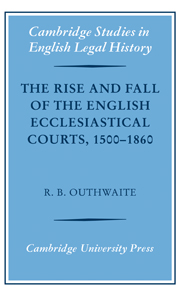Book contents
- Frontmatter
- Contents
- Foreword by R. H. Helmholz
- Preface
- Table of parliamentary statutes
- List of abbreviations
- 1 The ecclesiastical courts: structures and procedures
- 2 The business of the courts, 1500–1640
- 3 Tithe causes
- 4 Wills and testamentary causes
- 5 Defamation suits
- 6 Marital suits and marriage licences
- 7 Office causes
- 8 The roots of expansion and critical voices
- 9 Charting decline, 1640–1830
- 10 Explaining decline
- 11 The bills of 1733–1734
- 12 Snips and repairs: small steps to reform, 1753–1813
- 13 Royal commissions and early fruits, 1815–1832
- 14 Reform frustrated
- 15 Reforms thick and fast, 1854–1860
- Select bibliography
- Index
6 - Marital suits and marriage licences
Published online by Cambridge University Press: 21 January 2010
- Frontmatter
- Contents
- Foreword by R. H. Helmholz
- Preface
- Table of parliamentary statutes
- List of abbreviations
- 1 The ecclesiastical courts: structures and procedures
- 2 The business of the courts, 1500–1640
- 3 Tithe causes
- 4 Wills and testamentary causes
- 5 Defamation suits
- 6 Marital suits and marriage licences
- 7 Office causes
- 8 The roots of expansion and critical voices
- 9 Charting decline, 1640–1830
- 10 Explaining decline
- 11 The bills of 1733–1734
- 12 Snips and repairs: small steps to reform, 1753–1813
- 13 Royal commissions and early fruits, 1815–1832
- 14 Reform frustrated
- 15 Reforms thick and fast, 1854–1860
- Select bibliography
- Index
Summary
If the officials who administered the law in the English church courts in the sixteenth and early seventeenth centuries had had to rely on marital causes to maintain their incomes, they would quickly have become eligible for poor relief. Such causes, as we shall see, were rare at the outset and became rarer still as the period progressed. They merit discussion, however, because of this increasing rarity and because issues relating to both marriage and divorce played important strategic parts later in the drama relating to the dismemberment of church court jurisdiction in the eighteenth and nineteenth centuries.
Before the Reformation the law relating to the making of marriages and their dissolution was Roman canon law, and after the Reformation it was continued as the ‘King's ecclesiastical law of England’, the old canon law modified to a certain extent by statutes passed from 1534 onwards to the calling of the Long Parliament and the beginnings of the Revolution of the 1640s. In both eras – pre- and post-Reformation – that law was administered by the ecclesiastical and not the temporal courts. The latter had from the mid-twelfth century onwards, in Pollock and Maitland's words, ‘no doctrine of marriage’. If, as was sometimes the case in property suits, the temporal courts were asked questions in which the validity of a marriage was an issue, they would refer the matter to an ecclesiastical court.
- Type
- Chapter
- Information
- Publisher: Cambridge University PressPrint publication year: 2007



